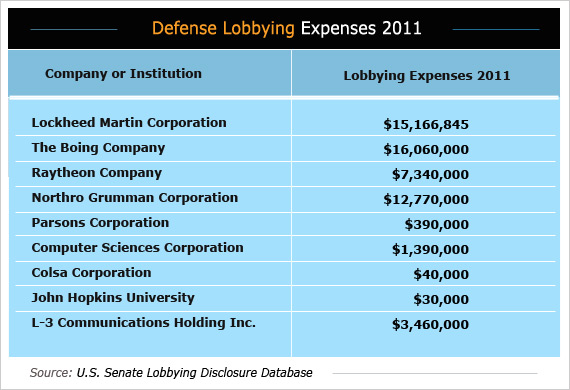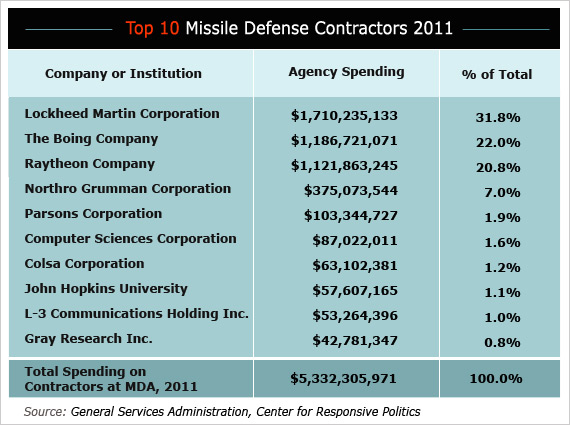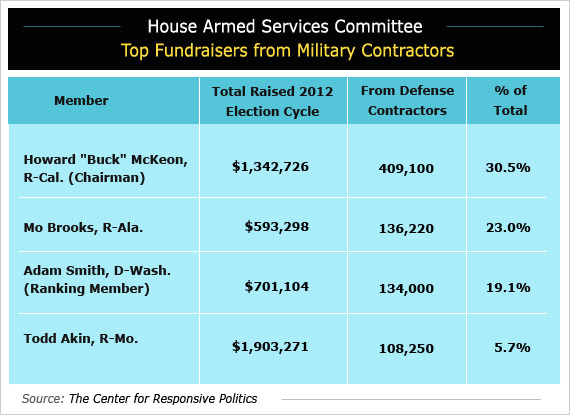In the three decades since President Ronald Reagan imagined a Star Wars-like defense against incoming Russian or Chinese missiles, the government spent more than $100 billion trying to make that dream a reality. Defense Department contractors have reaped over $80 billion in contracts from the Department of Defense’s Missile Defense Agency in the past decade alone, with another $44 billion committed through the end of 2016, according to a recent Government Accountability Office report.
Unfortunately, there’s not much to show for the effort, that is, if one uses as the criteria a proven ability to shoot down incoming missiles in simulated experiments, which some have likened to hitting an incoming bullet with another bullet. Despite partial deployment of land-based anti-missile missiles in California and Alaska and at sea on Aegis class cruisers and destroyers, the majority of experiments involving shooting down single missiles have ended in failure.
While the latest GAO report on the program showed better progress than previous years in meeting its goals, the bottom line assessment of system capabilities used phrases like “delivery of 12 missiles is on hold pending the results of the failure investigation of the anomaly that occurred during an April 2011 flight test” and “failed to intercept the target during its first flight test.”
Imagine what the limited system deployed to date would do against a missile launched amid a half dozen decoys that was armed with multiple warheads, which is state-of-the-art in countries like Russia with strategic nuclear capacity.
Meanwhile, any realistic survey of the world of emerging threats would find that North Korea has failed four times in its efforts to launch an intercontinental ballistic missile. Experts agree that the real threat is not from nation states, but rather from maverick terrorists who want to destroy us.
Iran’s medium-range missiles can’t hit the U.S. and the ruling mullahs aren’t trying to build long-range missiles. They have no nuclear weapons capacity, and this week, with economic sanctions tightening, Iran said it would open their nuclear facilities to international inspections to prove they weren’t trying to build some.
THE SNOOKI DEFENSE
Yet, the Republican-led House of Representatives earlier this month earmarked more money for missile defense in their $642.5 billion defense authorization bill, which could add another $3.6 billion to overall defense spending through 2017, according to the Congressional Budget Office. They want the Pentagon to start building batteries on the East Coast – what some have dubbed the Snooki defense because it could wind up along the Jersey shore – even though the West Coast-based system covers the entire continental U.S.
On Thursday, the Senate will mark up its own version of the defense authorization bill, and analysts say there is almost no chance East Coast missile defense will be included in its version of the bill, which is expected to adhere closely to President Obama’s Pentagon request. The military, it should be noted, is opposed to expanding the missile defense program and even Sen. John McCain, R-Ariz., a long-time advocate, told reporters this week he was “skeptical” about the need for an East Coast component.
But if the Pentagon isn’t for it, who is and why? In Washington, the easiest way to answer that question is usually summed up by the phrase, “follow the money.”
In a budgetary environment where many defense contracts are being cut and some are even on the chopping block, big defense firms are more than happy to sign on to a program that will shovel additional billions to keep employed the small army of engineers, designers, and computer programmers who write the millions of lines of code required to successfully intercept something moving faster than a speeding bullet. It’s just one of the reasons that defense contractors spend millions of dollars in campaign contributions and lobbying fees on Capitol Hill.

Lockheed Martin, for instance, which is the prime contractor on most components of the missile defense system, received $1.7 billion or nearly 32 percent of the more than $5.3 billion that the taxpayers poured into the program last year. Overall, the company, headquartered just outside Washington, D.C., won more than $40 billion in contracts from the Pentagon and other agencies in 2011, and spent $15.2 million on lobbying to keep the programs behind those contracts on track, according to the Center for Responsive Politics.
Lockheed and other defense contractors involved in missile defense are also the largest campaign contributors to leading members of the House Armed Services Committee. Its chairman, Rep. Howard “Buck” Mckeon, R-Calif., reaped more than 30 percent of the $1.34 million he’s raised so far in this election cycle from defense contractors with business before his committee.

It’s a bipartisan affair when it comes to feeding the military-industrial-congressional complex /node/59729. Rep. Adam Smith, D-Wash., whose suburban Seattle district contains major Boeing installations with thousands of workers, received over 19 percent of the $701,104 raised so far in this election cycle from defense contractors. Boeing received $1.2 billion in contracts from the Missile Defense Agency last year and spent more than $16 million on lobbying.
“Lockheed Martin, Raytheon and the other missile defense contractors are working this issue behind the scenes,” said William Hartung, a senior analyst at the Center for International Policy, a left-leaning think tank in Washington. “It would be a boon to them, particularly at a time of tightening Pentagon budgets.”
And in pursuing an expanded program, they know they can rely on legislators whose home districts will benefit from the contracts. During the floor debate in the House, for instance, Rep. Trent Franks, R-Ariz., touted how one particular missile, which happens to be built in Arizona, would be used in the east coast defense project. Defense contractors led by Lockheed donated $13,500 of the $204,000 he has raised so far for his re-election bid.
On the other hand, analysts who work closely with defense contractors dismiss the quid-pro-quo theory, which suggests campaign contributions are driving the demand to expand the missile defense program. “If they (the defense contractors) are out there working this issue, it’s news to me,” said Loren Thompson, the chief operating officer of the Lexington Institute, which does consulting work for several industry players.

That view gets support from long-time Pentagon analysts who suggest that Republican politics and the pork-barrel aspects of a program, which distributes dollars and jobs in numerous Congressional districts, are the most likely culprits behind the program’s charmed life. Their fear is that the program will expand despite its technical shortcomings should Republicans win control of the White House and Congress next year.
“This program has become an ideological litmus test for the Republican Party,” said Gordon Adams, a professor of international relations at American University and former Office of Management and Budget official in the Clinton administration. “Reagan invented it and every Republican who runs for office has to sign up for this puppy.”
So how does he explain the fact that even Democrats refuse to propose killing the program? First there’s the jobs that come with any government spending program. And then “there’s a reasonable prospect it might hit a target from time to time,” he said.




